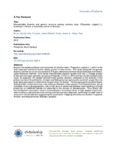Use este identificador para citar ou linkar para este item:
http://www.alice.cnptia.embrapa.br/alice/handle/doc/862276Registro completo de metadados
| Campo DC | Valor | Idioma |
|---|---|---|
| dc.contributor.author | BURLE, M. L. | pt_BR |
| dc.contributor.author | FONSECA, J. R. | pt_BR |
| dc.contributor.author | KAMI, J. A. | pt_BR |
| dc.contributor.author | GEPTS, P. | pt_BR |
| dc.date.accessioned | 2011-04-09T14:42:46Z | - |
| dc.date.available | 2011-04-09T14:42:46Z | - |
| dc.date.created | 2010-09-15 | pt_BR |
| dc.date.issued | 2010 | pt_BR |
| dc.identifier.citation | Theoretical and Applied Genetics, v. 121, p. 801-813, 2010. | pt_BR |
| dc.identifier.uri | http://www.alice.cnptia.embrapa.br/alice/handle/doc/862276 | pt_BR |
| dc.description | Brazil is the largest producer and consumer of common bean (Phaseolus vulgaris L.), which is the most important source of human dietary protein in that country. This study assessed the genetic diversity and the structure of a sample of 279 geo-referenced common bean landraces from Brazil, using molecular markers. Sixty-seven microsatellite markers spread over the 11 linkage groups of the common bean genome, as well as Phaseolin, PvTFL1y, APA and four SCAR markers were used. As expected, the sample showed lower genetic diversity compared to the diversity in the primary center of diversiWcation. Andean and Mesoamerican gene pools were both present but the latter gene pool was four times more frequent than the former. The two gene pools could be clearly distinguished; limited admixture was observed between these groups. The Mesoamerican group consisted of two sub-populations, with a high level of admixture between them leading to a large proportion of stabilized hybrids not observed in the centers of domestication. Thus, Brazil can be considered a secondary center of diversiWcation of common bean. A high degree of genome-wide multilocus associations even among unlinked loci was observed, conWrming the high level of structure in the sample and suggesting that association mapping should be conducted in separate Andean and Mesoamerican Brazilian samples. | pt_BR |
| dc.language.iso | eng | eng |
| dc.rights | openAccess | eng |
| dc.subject | Diversidade genética | pt_BR |
| dc.title | Microsatellite diversity and genetic structure among common bean (Phaseolus vulgaris L.) landraces in Brazil, a secondary center of diversity. | pt_BR |
| dc.type | Artigo de periódico | pt_BR |
| dc.date.updated | 2011-04-10T11:11:11Z | pt_BR |
| dc.subject.thesagro | Feijão | pt_BR |
| dc.subject.thesagro | Phaseolus vulgaris | pt_BR |
| dc.subject.thesagro | Variação genética | pt_BR |
| dc.subject.nalthesaurus | Beans | pt_BR |
| dc.subject.nalthesaurus | Genetic variation | pt_BR |
| dc.subject.nalthesaurus | Microsatellite repeats | pt_BR |
| riaa.ainfo.id | 862276 | pt_BR |
| riaa.ainfo.lastupdate | 2010-10-28 | pt_BR |
| dc.identifier.doi | https://doi.org/10.1007/s00122-010-1350-5 | eng |
| dc.contributor.institution | MARILIA LOBO BURLE, CENARGEN; JAIME ROBERTO FONSECA, CNPAF; JAMES A. KAMI, UNIVERSITY OF CALIFORNIA; PAUL GEPTS, UNIVERSITY OF CALIFORNIA. | pt_BR |
| Aparece nas coleções: | Artigo em periódico indexado (CNPAF)  | |
Arquivos associados a este item:
| Arquivo | Descrição | Tamanho | Formato | |
|---|---|---|---|---|
| eScholarship.pdf | 563.88 kB | Adobe PDF |  Visualizar/Abrir |









